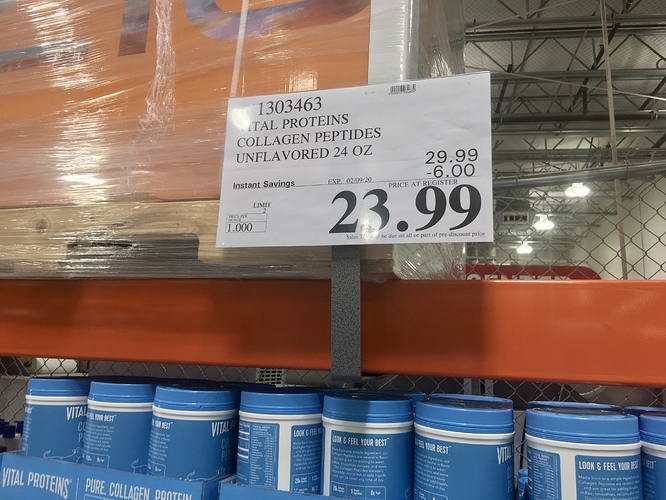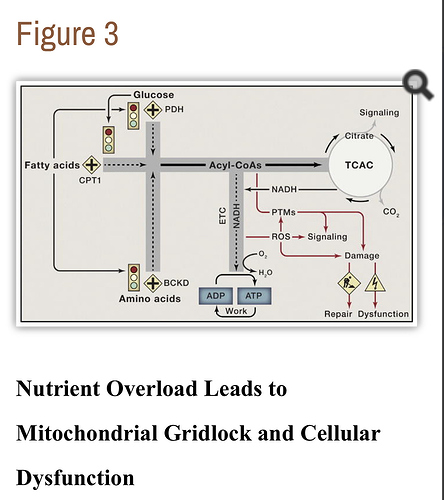I don’t track anymore since just trying to maintain but I would say around 0.6 also. I eat a pretty good variety of protein - hamburger, ribeye steak, pulled pork, ham, chicken, etc. Not as much seafood, but some.
How much collagen in everyday foods?
This is encyclopedic, and dated 1989. Don’t know whether or not updated since. Tremendous amount of info here, though. I’ll try to find more recent data and something in more summary format.
@Don_Q @Janie My current macro includes 100 grams of protein calculated from 1.53 grams per kilogram of total body weight of ~144 pounds (127 lean - 17 fat).
144/2.2 x 1.53 = 100 (rounded)
Can you text my 86-yo Dad and convince him he needs more than 25 g of protein per day???
His gf is vegan so he is on an island when it comes to protein. She doesn’t cook and just mixes “potions” for nutrients. His health and strength is declining, as expected.
This is from 2011. It’s specifically how to combine plant-source protein for optimal human nutrition, but it includes much useful data about amino acid proportions.
 I doubt it. The gf means more to him than anyone else - even if she’s killing him. Send him this link and let him figure it out for himself. If he doesn’t care enough, there’s not much you can about it:
I doubt it. The gf means more to him than anyone else - even if she’s killing him. Send him this link and let him figure it out for himself. If he doesn’t care enough, there’s not much you can about it:
https://www.calculator.net/protein-calculator.html
In addition to the calculator there’s lots of good info.
Tldr: hamburger is staying in the menu. 
At first glance, the methionine risk seems like a bit of a nothing-burger which is comforting (I do love my hamburger). Granted it’s just one article (linked below), and there could be more to the story. That said, even Saladino concedes glycine mitigates the risk, though he’s curiously mum on riboflavin which muscle meat is packed with. That’s odd to me, and the cynic in me wonders.
At any rate, there doesn’t appear to be evidence that increased methionine consumption causes elevated homocysteine. It’s fortuitous that it doesn’t because surplus methionine is coverted to homocysteine, and elevated homocysteine is associated with heart disease, so thats what the fuss is about.
Fortunately, elevated homocystine levels are automatically lowered to the normal range in the presence of riboflavin and/or glycine both of which are found in muscle meat. Ironically, the cheaper the meat you buy, the safer you are in this regard because cheap meats are loaded with collagen and therefore glycine. Even in the absence of glycine, riboflavin appears to be sufficient to regulate homocystine/methionine homeostasis, and muscle meat is packed with riboflavin. No collagen supplement required even absent glycine.
Table 6.1 is a nice summary of the RDA for each of the 9 essential aminos. I’m definitely hitting those targets with room to spare.
On the subject of “excessive protein”, this report says that something to the effect of "it’s generally regarded as prudent to remain below 2x the recommended daily protein intake. They’re recommending .75g/kg, and I’m at 1.3g/kg, so I’m still within spec.
Hamburger stays on the menu. 
Yah, like I said, I think one pound of any meat is probably just fine; and, as you’ve stated, ground probably has slightly more glycine and slightly less methionine anyhow.
Yes, there is. I was being a lazy girl yesterday. I’ll dig up some papers today and actually read them rather then skim. 
I’m confused, these two sentences are saying the opposite things. Also, from the article you linked:
“Excessive consumption of methionine may lead to elevated blood levels of homocysteine”
What is clear from the article is that the link between homocysteine and heart disease is correlational and weak since decreasing homocysteine levels does not improve heart events. But that doesn’t get methionine off the hook since something that is causing elevated homocysteine is also causing increased heart risk and increased methionine is apparently causative in increasing homocysteine. I will agree it’s thin though.
“In the presence of” or in certain ratios with? Do you have any references. I’d like to read more about this.
From the linked article:
" Riboflavin. Though riboflavin is also necessary to make this process work, riboflavin supplements have limited effects on homocysteine levels"
I’d love to see whatever you’ve read on this.
Check out this article.
High methionine in a diet actually reduces the amount of glycine and serine actually worsening the situation. Only by adding high amounts of glycine was this enhancing effect on methionine mitigated.
https://www.ncbi.nlm.nih.gov/m/pubmed/3668700/
This is the other line of concern over methionine. It seems to increase oxidative stress and excessive amounts lead to reduced longevity.
“Reducing dietary levels of methionine, an essential amino, in rodents was shown to partially mimic the effects of CR and induce lifespan extension. This topic has been extensively reviewed. Many of the protective effects of DR are blocked by adding back methionine to the diet.”
In this case as well high glycine mitigates methionine’s impact. But the ratio is what matters not just the presence of glycine since a high methionine to glycine ratio overwhelms the system and results in reducing the amount of glycine.
Anyhow, that’s it for now. There is a lot of science on this topic. It’s enough to convince me that you want to keep glycine up and not eat excessive muscle meat.
Lol. It’s enough to convince me too. In a rare moment of self-awareness, it occurred to me that I could spend countless hours trying to figure out “ideal” amino ratio and still have no idea because the research will turn out to be incomplete, primarily based on animal models, and often contradictory.
I’m just going to go with dietary rule # 1. Eat real foods. People throughout the world have been eating collagen rich broths since the invention of fire. It’s unlikely that something that’s both venerated in China and also affectionately nicknamed “Jewish penicillin” isn’t at least a little bit good for you… 
I’m going to use up my heavily processed collagen isolates over the next couple weeks, and when it’s gone, I’m going to start adding a bit of bone broth made from chicken backs, chicken feet, and pigs feet to my diet. I enjoy canning, and I’ve got a 23 quart pressure canner that allows me to can a months worth of broth at a time. This seems like a good use for it, and it’ll be good for my kids to see some nose-to-tail cooking while they’re young. 
I love the stuff!
I also like it cold and gelled with lots of meat, and skin and marrow in the gel (I prefer it this way in summer). It’s what I call aspic, not the gelatin and hotdog creation. 
Im new at this But I am planing on losing a lot of weight, I am down near 20 lbs now and want to go at least 100 more
I am concerned about loose skin
I do eat a good amount of meat, Burgers, Steaks, Bacon, Chicken wings as wells as eggs and Cheese
Is this powder something I should add?
The only concern is the added protein as I do get a lot as is, And look for ways to add fat
Plan On doing that as well, Dont want to take any unnecessary chances
Had a real problems waking up and eating for 10 years, That stopped 2 and half weeks ago,
And I started skipping either lunch or breakfast during weekdays
2 days last week did 20/4 didn’t eat till dinner
So its a work in progress but moving in the right direction well enough
I thought this was interesting to, apparently the human body can make glycine from the amino acid serine {Vitamin B6 as a cofactor; is found in soybeans, nuts (especially peanuts, almonds, and walnuts), eggs, chickpeas, lentils, meat, and fish (especially shellfish)} endogenously but requires folate (what a lot of meat only eaters will be deficient in; beef liver anyone?) for biosynthesis into glycine or “…All three compounds (serine, ethanolamine[1] and choline), can be used as nitrogen bases in glycerophospholipid formation…” But cannot happen without vitamin B-6 for biosynthesis.

Some forms of epilepsy are responsive to simple B-6 supplementation[3].
Methionine can be converted into choline[5].
References:
[1] “…The major group, ethanolamine, can be obtained from various dietary sources. Ethanolamine is then converted into phosphatidylethanolamine via several enzymatic reactions. Phosphatidylethanolamine is converted to phosphatidylcholine with the help of methyl groups. It is involved in preserving central nervous system functions and structure, also playing a key role in normal neural tissue health. …” …More
[2] Vitamin B6 is essential for serine de novo biosynthesis.
[4] “…Methionine is an antioxidant by contributing sulfur atom in the synthesis of cysteine. Inadequate intake of methionine can adversely impact the synthesis of cysteine and hence GSH (Glutathione), one of the key endogenous antioxidant. In liver, methionine is adenosylated and is then converted to s-adenosyl methionine (SAM). SAM is then converted to s-adenosyl homocysteine (SAH). In the presence of vitamin B6, SAH (S-adenosyl-l-methionine) is converted to cystathione and then cysteine (Stipanuk, 1986). This cysteine is then used in biosynthesis of glutathione along with serine. …” …More
[5] “…Methionine can be converted to cystine but cystine cannot be converted back to methionine. Choline is therefore effective in sparing methionine, because, with an adequate level of choline in the diet, methionine is not needed for choline synthesis. …” …More
[6] SAM/SAH Analogs as Versatile Tools for SAM-Dependent Methyltransferases
If I recall, the limiting factor isn’t folate deficiency, its that our ability to synthesize glycine greatly diminishes as we age. Exogenous glycine saves us the trouble.
I wonder if your statement holds true if you bring down glucose and bring up ketones with the help of zinc you may be re-igniting the phosphorylation spark in the mitochondria?
If we have three fuels (amino acids, glucose, fatty acids) trying to hit the fire; what intersecting process controls it? NADH (nicotinamide adenine dinucleotide)? Acetyl - CoA is produced by the breakdown of both carbohydrates (by glycolysis) and lipids (by β-oxidation)? What about amino acids?
image link
Guess you’d be referring to this?
[2] “…Studies indicate that the requirements of B6 in elderly people are higher due to decreased absorption, increased catabolism and impaired phosphorylation [18,19]. Elderly people are at risk of B6 deficiency because they consume less food, in particular food containing B6. …” …More
[4] Regulation of glycine receptor diffusion properties and gephyrin interactions by protein kinase C.
Omg @atomicspacebunny. I knew I’d read in some paper that our aging related decrease in protein synthesis efficiency was itself diet related but I could never find the reference again and it’s been driving me mad ever since. I think you’ve just given me what I’ve been looking for ages. I haven’t read them yet but this will be my deep dive of the day for sure. Thanks!



